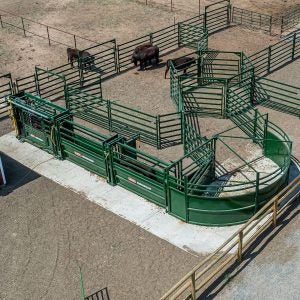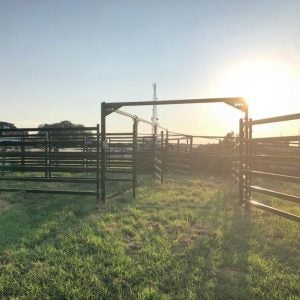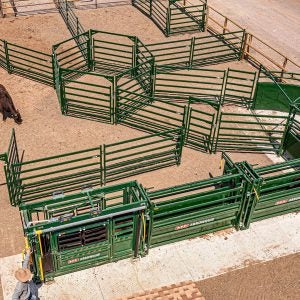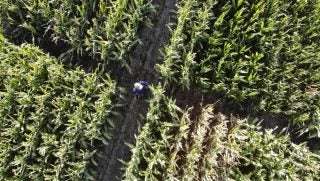Ready to make some changes to your beef cattle corral design? Designing new beef cattle corrals and handling facilities is an exciting time for your operation, but can bring with it a number of challenges and stresses that take away from the fun of the process. If you slow down and take the time to think through what you really need with your cattle corral upgrade, you can take the guesswork out of the process to make it as simple as possible, and ensure that your new equipment fits the bill just right.
Before you dive all-in, start with a high-level plan.
Put together a list of the features that are need to haves, nice to haves, and not necessary. It is important to think about the tasks that you complete regularly, and also the one-off situations that happen a few times a year like pulling a calf. This is the stage of designing your cattle corral where you can dream and put together the ideal corral system for your needs.
This high-level plan should include everything you could possibly want — bringing it in on budget can be sorted out afterward. There are two key reasons to do this.
- If you list out every desirable feature for your operation you are unlikely to forget anything.
- You can get creative and find alternative solutions to fulfil those needs later, if you know what they are.
Make a list and a high-level plan for your new beef cattle corral before you dive all-in to the design process and ironing out the details in these next steps.

Now that you have a preliminary plan in place, here are five simple steps that can simplify the process of designing beef cattle corrals and handling facilities for your operation.
1. Pick the right location.
There’s an old saying that location is everything, and it really is true when it comes to choosing a location for your beef cattle corral. You want to choose a convenient location that is centrally located on the ranch, where you can easily bring in trucks and trailers carrying livestock to unload them, and that has access to water and electricity. Shade for handlers is also something to keep in mind.
A few other key factors to consider when choosing a location for your beef cattle corral are drainage, the slope of the land, protection from the elements, and proximity to neighboring properties.
Once you’ve chosen your location, take on any required site work ahead of time, including leveling land, pouring concrete, etc. It is much easier to adjust a site to add drainage or fix the slope before your facilities have been installed.
Choosing and preparing the best location for your beef cattle corral can be a difficult first part of the design, but it will pay off by saving you time and money down the road.
2. Size and scope of your beef cattle corral design.
Every cattle operation has unique needs and challenges that need to be addressed, and if you are planning on expanding your operation in the coming years, it is important to keep that in mind when designing a new cattle corral. You want to make sure your facilities can adapt and grow with the needs of your operation over time.
There are many factors that impact the size and scope of your beef cattle corral design, most importantly the projected growth of your cattle herd. Keeping your plans for the future in mind when putting together the initial design can make all the difference when it is time to make modifications or expand your cattle corrals down the road.

3. Longevity of the cattle corrals and equipment you are choosing.
Cattle equipment of any kind is an investment, and investing in a new cattle corral is a large one for any operation. Taking the time to truly plan out a beef cattle corral that will fit the needs of your operation while using low-quality components is a choice you may regret down the road.
Instead, choose equipment and cattle corral components that are built to last. Quality matters and will greatly impact the longevity of the equipment you install in your beef cattle corral. While those components may cost more upfront, the longevity of your equipment and safety associated with high-quality parts will pay off in dividends over time.
Consult other producers for recommendations, and take the time to do your research. There is always time to consider the options before you, and it is best to take extra time to make the right decision rather than having an impulse purchase you regret down the road because it does not fit your needs.
4. Flexibility to work cattle solo, as needed.
Sometimes, you have no choice but to work cattle alone. Choosing equipment that gives you the freedom to work cattle by yourself in the event of an emergency is an important thing to keep in mind when designing beef cattle corrals, because you never know when you may need to pull a calf or treat an animal quickly.
Your beef cattle corral should be designed to work livestock solo in the event of an emergency, while also providing the features you need when working with a large group of handlers. Place your cattle alley gates strategically to control the flow of beef cattle, and choose equipment that is designed for a single operator to use. This is most important with the squeeze chute you choose — the best options available are a hydraulic or Q-Catch model that allows a single operator to close the tail gate and head gate simultaneously from the back of the chute.

5. Return on Investment (ROI).
When making a big investment for your ranch, it is important to think about the return on your investment. Make sure that the facility you are building will pay off in the short term by making your operation safer and minimizing injuries, reducing cattle bruising for higher sale profits, or by lowering the number of handlers you need to effectively work your livestock.
In addition, think about the long-term investment and choose a manufacturer that backs their equipment with a good warranty program and customer service that will be there for you in the event that an issue arises.
Choosing reliable equipment for your beef cattle corral will pay off in the short and long term will benefit your operation in countless ways, and undoubtedly provide the best return on investment.
Designing beef cattle corrals and handling systems is a tricky task for any operation, but with the right considerations put in place before you start the process, it is one that can be very rewarding for your operation.
Arrowquip is on a mission to make ranching families safe by providing them with highly durable, smart cattle chute and handling equipment designs that make it easier to manage livestock. Cattle are crazy enough, so ranchers have put cattle chute safety at the forefront of their designs for a better cattle working experience.
For more information, visit arrowquip.com/cattle-equipment or contact leads@arrowquip.com.
This article was published on behalf of Arrowquip.


